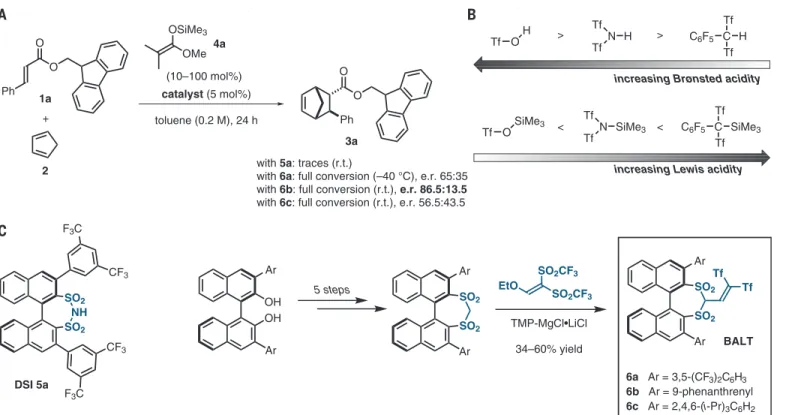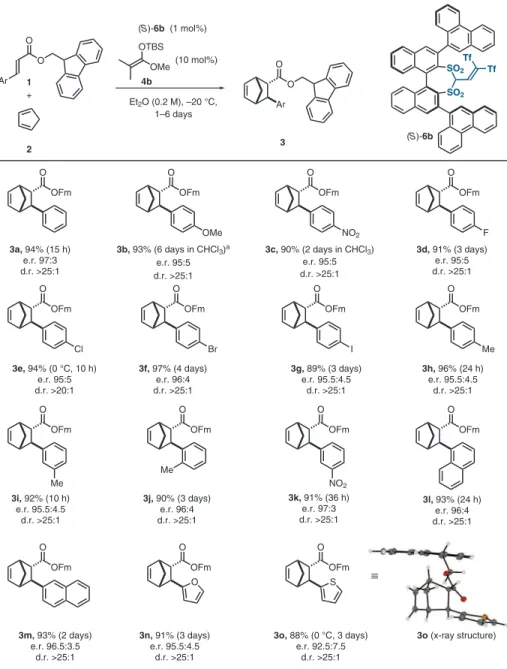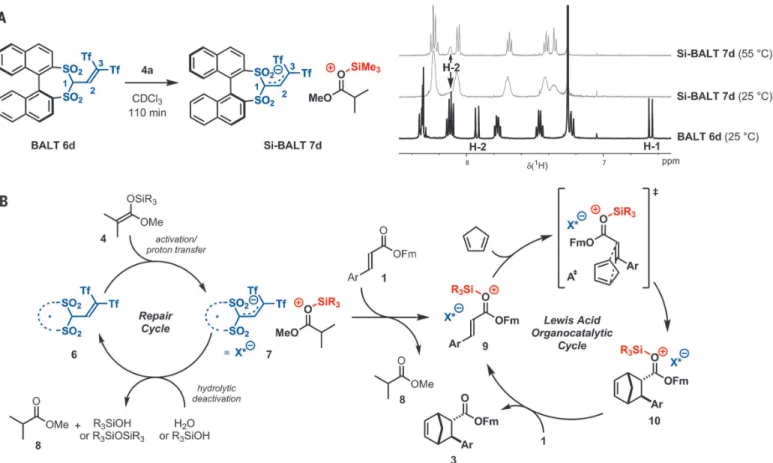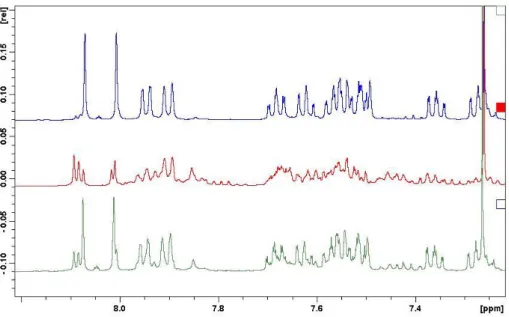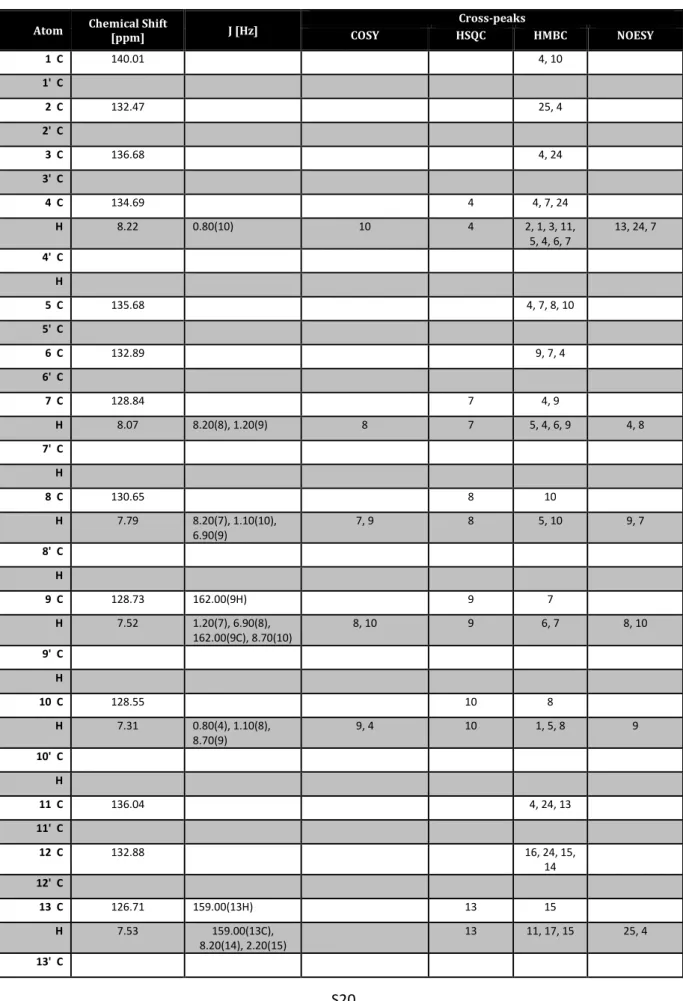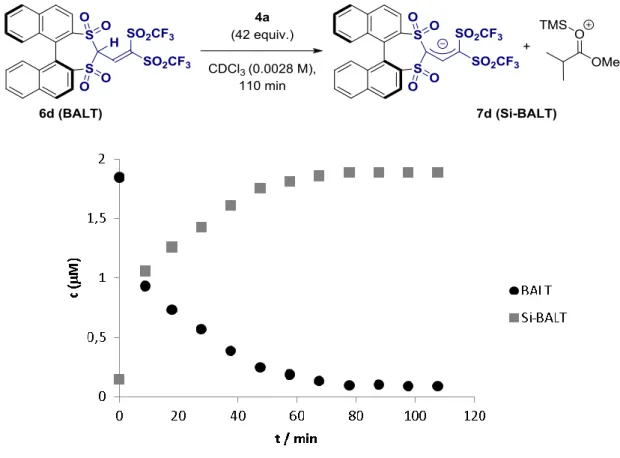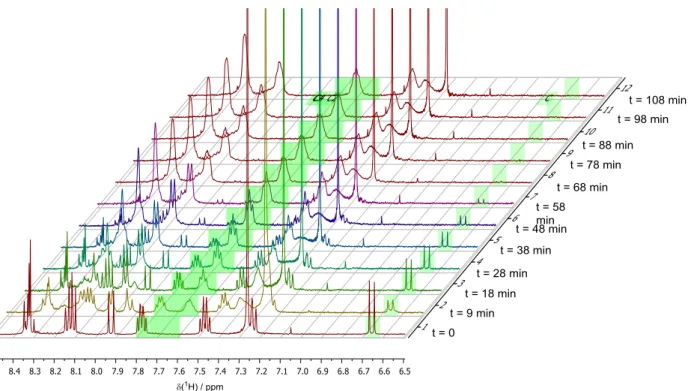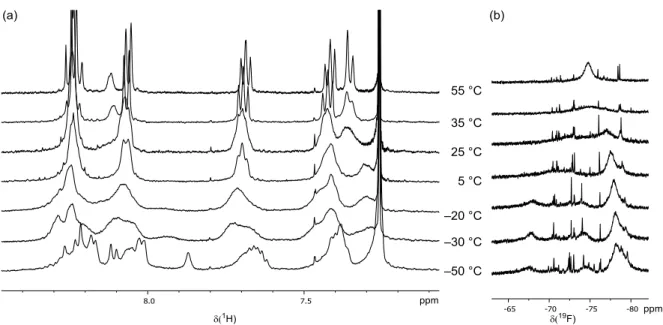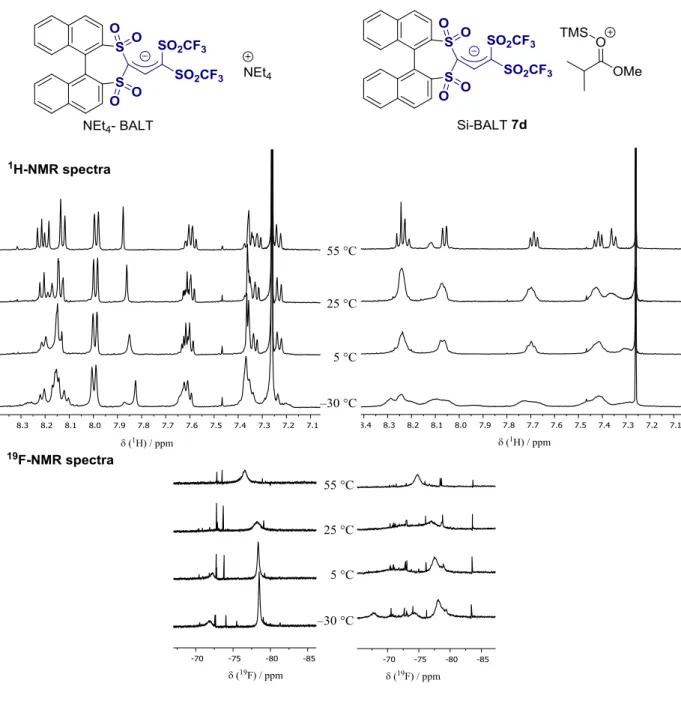Asymmetric Counteranion-Directed Lewis Acid Catalysis with α,β-Unsaturated Esters
I n a u g u r a l - D i s s e r t a t i o n
zur
Erlangung des Doktorgrades
der Mathematisch-Naturwissenschaftlichen Fakultät der Universität zu Köln
vorgelegt von Tim Gatzenmeier
aus Elmshorn
Köln 2018
Berichterstatter: Prof. Dr. Benjamin List
Prof. Dr. Hans-Günther Schmalz
Tag der letzten mündlichen Prüfung: 04.09.2018
“To improve is to change; To perfect is to change often.”
Winston Churchill
Acknowledgements
I
Acknowledgements
The work presented in this dissertation was conducted between April 2014 and July 2018 at the Max-Planck-Institut für Kohlenforschung in Mülheim an der Ruhr under the guidance of Prof. Dr. Benjamin List.
Ben
Where should I start…I have to express my greatest gratitude to you for giving me the incredible opportunity to conduct my PhD studies under your supervision. I feel I have matured both as a scientist but also in character over the years from your influence. Your open mind set about chemistry, the provided maximum degree of freedom, the relaxed group atmosphere and the legendary boat trips over the years helped me to overcome the reappearing challenges and obstacles of the PhD work. In addition to the occasional critical feedback to make me aware of my weaknesses, you have provided me with very strong support for prizes and applications, and rewarded me with one of the greatest gifts a scientist can receive: attending highly prestigious conferences to present its own research, including the unforgettable time on Hawaii for the PacifiChem 2016. I have the greatest respect for your idealistic approach to science and chemical reaction development and the very high standards attached. Some (not so serious) lessons I particularly enjoy to remember: how to best delegate work, how to attract and spend research money, how to digest a shit sandwich, how to enjoy exotic drinks (on fire). Once again thank you very much for the extraordinary, intense time!
Defense committee
I would like to thank Prof. Dr. H. ‒G. Schmalz for accepting to act as second reviewer for my dissertation, Prof. Dr. A. Klein for acting as chairman of my defense committee and Dr.
Monika Lindner for offering to act as Beisitzer.
Cooperation partners
I thank all my cooperation partners for the extraordinary efforts, which made all our highly relevant scientific results possible: Manuel van Gemmeren for his help and suggestions during my Master thesis and for entrusting me with continuing his work on chiral C–H acids.
Youwei Xie for this support on the scope of our first asymmetric Diels–Alder reaction and
Acknowledgements
II
sharing of IDPi catalysts. Denis Höfler for re-preparing catalyst in higher quantities. Markus Leutzsch for his support in mechanistic NMR studies. Philip Kaib for providing me with IDPi lead structures. Julia Lingnau for her many NMR measurements and assignments. Richard Goddard for his X-ray structure analysis. Mathias Turberg for his support on the diene scope of our second-generation asymmetric Diels–Alder reaction. Diana Yepes, Giovanni Bistoni and Frank Neese for their comprehensive computational studies. Finally, I thank Vanda Daskova for joining the Mukaiyama–Michael chemistry as a Master student.
Technicians, analytical departments and staff
I greatly acknowledge the excellent service provided by the technician team of the List laboratory providing catalysts and intermediates, especially Arno Döhring for his repeating large-scale preparation of cyclopentadiene. I thank all analytical departments of our institute for their service, especially the HPLC and GC department for their enormous help in separating chiral compounds. Special thanks to Alexandra Kaltsidis and Monika Lindner for helping with many administrative concerns and lab & organization issues, to Chandra De, not only for his many initiatives to improve our lab & research, but also for the many discussions about chemistry and the frequent advice. Finally, I thank Martin Klussmann for his teaching efforts in our POC seminars and the discussions about peculiar results.
Football team members
After finishing in 4 th position in my first year, in 2015 we finally won the prestigious KoFo- Cup for the first time! In the subsequent years (2016‒2018), we decided to be good colleagues and let different teams win the final ‒ out of pure courtesy of course. Many thanks to the many fun football training sessions, the perfect team spirit and the great success to my team members over of these years: Gabriele Pupo, Mattia Monaco, Tom James, Theo List, Gabriele Cerai, Aurelien Tap, Steffi Dehn, Alex Zwerschke, Raja Mitra, Marc Meyer, Mike Perryman, Suzanne Willems, Jenny Kennemur, Nobuya Tsuji, Marcel Lux and Mathias Turberg.
Colleagues, friends and unofficial mentors
People before me referred to the “Mülheim family” as all the people that were responsible
for having the time in Mülheim an der Ruhr also enjoyable outside of the lab. Thank you all
for your dear friendship and companionship: Aurelien Tap (best hood neighbor of all times,
although working with sulfur compounds), Gabriele Pupo (best Hawaii travel partner of all
Acknowledgements
III
times), Mattia Monaco (best party mate for Ballermann of all times, if we really go), Francesca Mandrelli (the social “glue” and award-winning host of all umbria), Jennifer Kennemur (most talented female PhD student I have witnessed in our lab), Desi Petkova (most capable party hosting partner), Quinggang Wang (early days unofficial mentor and personal role model), Carla Obradors (best political discussion leader), Diane Becart (best gym mate with Dave), Mathias Turberg (most talented cooperation partner I have had so far). Special thanks also to Mathias Turberg and Diane Becart for proof-reading my dissertation. I also thank all other members and alumnis of the List laboratory for the great group atmosphere.
My Family
Finally, I am deeply grateful to my family for their constant support throughout my
education from the distance.
Table of Contents
IV
Table of Contents
Acknowledgements ... I Table of Contents ... IV Abstract ... V List of Abbreviations ... VI
1 Introduction & Objective ... 1
1.1 Background ... 1
1.2 Objective ... 6
2. Asymmetric Lewis acid organocatalysis of the Diels–Alder reaction by a silylated C–H acid ... 9
3. The Catalytic Asymmetric Mukaiyama–Michael Reaction of Silyl Ketene Acetals with α,β-Unsaturated Methyl Esters ... 87
4. A Scalable and Highly Diastereo- and Enantioselective Catalytic Diels−Alder Reaction of α,β-Unsaturated Methyl Esters ... 143
5. Summarizing Discussion ... 244
6. Summary & Outlook ... 251
7. Bibliography ... 253
8. Appendix ... 257
8.1 Eigene Beiträge an den zu Grunde liegenden Veröffentlichungen Own contribution to the incorporated publications ... 257
8.2. Erklärung/Declaration ... 258
8.3. Lebenslauf/CV ... 259
Abstract
V
Abstract
The fundamental substrate class of α,β-unsaturated esters offers extraordinary synthetic potential for carbon-carbon bond forming reactions, such as cycloadditions and conjugate additions, however is rarely applied in asymmetric catalysis due to its relatively low reactivity. By expanding the concept of silylium-ACDC to non-silicon transfer reactions (catalytic in silicon), the introduction of chiral C–H acids into asymmetric catalysis and the identification of two distinct families of imidodiphosphorimidates (IDPi) catalysts, we could report unprecedented highly enantio- and diastereoselective Diels–Alder and Mukaiyama–
Michael reactions of simple α,β-unsaturated methyl esters. The developed extremely active chiral Lewis acids represent the most efficient catalysts for asymmetric Diels–Alder reactions of α,β-unsaturated esters to date while tolerating a very broad scope on a variable scale with catalyst loadings as low as 0.1 mol%.
Kurzzusammenfassung
Die grundlegende Substratklasse der α,β-ungesättigten Ester bietet herausragendes
synthetisches Potential für Kohlenstoff-Kohlenstoff Bindungsknüpfungsreaktionen wie
Cycloadditionen und konjugierte Additionen, wird jedoch in der asymmetrischen Katalyse
aufgrund ihrer relativ niedrigen Reaktivität kaum angewendet. Durch die Erweiterung des
Konzept der asymmetrischen Gegenanion-vermittelten Katalyse mit Silylium-Equivalenten
(silylium-ACDC) hin zu Reaktionen mit katalytischen Mengen Silizium, die Einführung von
chiralen C–H Säuren in die asymmetrische Katalyse und die Identifizierung von zwei
separaten Familien an Imidodiphosphorimidat-Katalysatoren, konnten bisher beispiellose
hoch enantio- und diastereoselektive Diels–Alder und Mukaiyama–Michael Reaktionen
beschrieben werden. Die entwickelten chiralen Lewis Säuren stellen die bis dato
effizientesten Katalysatoren für asymmetrische Diels–Alder Reaktionen von α,β-
ungesättigten Estern dar und tolerieren trotzdem ein sehr breites Substratspektrum auf
verschiedenen Reaktionsmaßstäben mit sehr niedrigen Katalysatorbeladungen von bis zu
0.1 mol%.
List of Abbreviations
VI
List of Abbreviations
* designating chiral element
ACDC asymmetric counteranion-directed catalysis Alk alkyl
Ar aryl
aq. aqueous
BINOL 1,1’-bi-2-naphthol
Bn benzyl
Boc tert-butyloxycarbonyl
br broad
cat. catalyst or catalytic conc. concentrated conv. conversion d doublet or day(s)
DCE dichloroethane
DCM dichloromethane
DFT density functional theory DMAP 4-dimethylaminopyridine DMF dimethylformamide DMSO dimethylsulfoxide d.r. diastereomeric ratio Elec. electrophile
EI electron impact ionization e.r. enantiomeric ratio
equiv. equivalents
List of Abbreviations
VII
Et ethyl
et al. et alii/et aliae – and others ESI electrospray ionization
GC gas chromatography (gas chromatography coupled with mass detection)
h hour(s)
HPLC high performance liquid chromatography HRMS high resolution mass spectrometry
HX* designating chiral Brønsted acids, e.g. chiral phosphoric acid diesters
i iso
m meta
m multiplet
M molar or metal
Me methyl
MS mass spectrometry or molecular sieves MTBE methyl tert‐butyl ether
MW molecular weight
NMR nuclear magnetic resonance (spectroscopy) NOE nuclear Overhauser effect
NuH/Nuc. nucleophile
o ortho
P product
p para
Ph phenyl
Pr propyl
quant. quantitative quint quintet
rac racemic
List of Abbreviations
VIII r.t. room temperature
sat. saturated t tert, tertiary
t triplet
T temperature
Tf trifluoromethylsulfonyl THF tetrahydrofuran
TLC thin layer chromatography TMP 2,2,6,6-tetramethyl piperidine TMS trimethylsilyl
TON turnover number
TRIP 3,3'-bis(2,4,6-triisopropylphenyl)-1,1'-binaphthyl-2,2'-diyl-hydrogen phosphate
TsOH para-toluenesulfonic acid
1 Introduction & Objective
1
1 Introduction & Objective
1.1 Background
In asymmetric catalysis, the majority of reactions proceed through partially charged or completely ionic intermediates. When anionic intermediates are involved such as negatively charged nucleophiles, chiral enantiopure countercations can render subsequent transformations enantioselective upon sufficient association of the ion pair (Scheme 1.1).
This principle has widely been applied in enantioselective phase-transfer catalysis (PTC). 1 Asymmetric induction upon ion-pair formation may also proceed with a crucial anionic partner. In the concept of asymmetric counteranion-directed catalysis (ACDC), a cationic species, such as a protonated intermediate, forms an ion pair with a chiral anion, which directs enantiotopos/-face-differentiation or enantiomer-differentiation. 2,3
Scheme 1.1 Schematic representation of ion pairs in enantioselective catalysis: phase- transfer catalysis with chiral countercations (PTC) and asymmetric counteranion-directed catalysis (ACDC) with chiral counteranions. P = product; S = substrate; X = anion; NR 4 -
= chiral ammonium ion; cat. = cation (H + ).
A general definition of ACDC is given as: “Asymmetric counteranion-directed catalysis refers
to the induction of enantioselectivity in a reaction proceeding through a cationic
intermediate by means of ion pairing with a chiral, enantiomerically pure anion provided by
the catalyst.” 2 The term ion pair is further defined according to Anslyn and Dougherty: “An
ion pair is defined to exist when a cation and anion are close enough in space that the
energy associated with their electrostatic attraction is larger than the thermal energy (RT)
1 Introduction & Objective
2
available to separate them.” 4 Further attractive interactions, in addition to the Coulomb attraction, between cation and anion may be involved in the context of ACDC. 2 The term ion- pair catalysis is understood in a broader sense merging the concepts of phase-transfer- catalysis and asymmetric counteranion-directed catalysis. 5 Thus, catalyzed reactions proceeding through ion pairs in general are categorized into this class of catalytic processes.
A proof-of-principle on the feasibility of ACDC as a powerful strategy for asymmetric catalysis beyond Brønsted acid catalysis was delivered by List and coworkers in 2006 for the highly enantioselective transfer hydrogenations of enals using a Hantzsch ester as the reductant (Scheme 1.2). 6 The morpholinium salt of TRIP phosphoric acid (1) forms a chiral ion pair upon condensation with the enal substrate. The chiral anion directs the approach of the hydride source to the reactive iminium intermediate by enantiofacial steric shielding.
The chiral ion pair intermediate as being present in the enantiodetermining step renders this reaction a clear showcase of ACDC. The high potential of this concept was rapidly realized and let to many applications in enantioselective organocatalysis but also in transition-metal catalysis featuring chiral enantiopure anions. 2-5-7
Scheme 1.2 Proof-of-principle for asymmetric counteranion-directed catalysis (ACDC): The catalytic asymmetric transfer hydrogenation of enals with the salt of morpholine and TRIP phosphoric acid.
While enantioselective Brønsted acid catalysis is particularly successful for relatively
electrophilic and/or basic substrates, such as imines, Brønsted acidic activation of substrates
such as aldehydes, ketones, unsaturated carboxylic acid derivatives and olefins is profoundly
more challenging. Thus, the focus shifted towards organic Lewis acids as potential catalysts
for activating such substrates. In the presence of silylating agents, Brønsted acids such as
triflic acid (TfOH) and triflimide (Tf 2 NH) can be converted into their silylated analogues,
which are very potent Lewis acids. 8-9 As indicated by trends in pK a values, triflimide
1 Introduction & Objective
3
(pK a = –11.9 in DCE; pK a = 0.3 in MeCN) 10 is turned into a much stronger Lewis acid upon silylation then triflic acid (pK a = –11.4 in DCE; pK a = 0.7 in MeCN) rendering TMS-NTf 2 a promising motif for chiral organic Lewis acids. 11 For previously reported metal-based Lewis acid-catalyzed asymmetric transformations, such as Mukaiyama–Aldol reactions, a major issue was competition between the desired enantioselective Lewis acid catalysis and a non- enantioselective pathway catalyzed by silylium ions. 12-13 By taking advantage of silylium ions/equivalents as potent Lewis acid, it was envisioned that a combination with a suitable chiral anion may render this pathway enantioselective through ACDC. In 2009, List and coworkers reported the first realization of this concept featuring chiral disulfonimide (DSI) catalysts in Mukaiyama–Aldol reactions of aromatic aldehydes with silyl ketene acetals to give excellent yields and enantioselectivities. 14 Disulfonimides as Brønsted-acidic pre- catalysts are silylated to form the active species (Scheme 1.3). Residual water in the reaction mixture is transformed into TMS 2 O via catalyst hydrolysis and re-silylation by the silylated reagent, which is present in excess. In the dormant phase of the reaction, this process is continued until all water is consumed into TMS 2 O. 15 The highly relevant ability of catalyst regeneration after hydrolysis under silylating conditions is referred as self-healing or self- regeneration. Aldehyde substrates are activated through complexation of the silyl group forming a chiral ion pair which allows effective enantiofacial differentiation. Upon nucleophilic attack of the silyl ketene acetal, the primary reaction product collapses to give the product and to regenerate the silylated catalyst.
Scheme 1.3 General catalytic cycle for asymmetric Lewis acid catalysis with silylium ion
equivalents and chiral counteranions.
1 Introduction & Objective
4
The existence of underlying Lewis acid catalysis was supported by experiments in the presence of 2,6-di-tert-butyl-4-methyl pyridine as a Brønsted acid scavenger, which did not suppress the reaction. The shown catalytic cycle is considered to be general for the activation of aldehydes in reactions with silylated nucleophiles. This concept and the novel class of chiral Brønsted acids led to a renaissance of asymmetric Lewis acid catalysis for transformations of carbon electrophiles, such as aldehydes and imines, with silylated nucleophiles (Scheme 1.4). 16-17 Aromatic aldehydes and imines are preferred substrates for silylated DSI catalysts and have subsequently been used for a series of other transformations with various silylated nucleophiles resulting in consistently high enantioselectivities. In analogy to the common Mukaiyama–Aldol reaction with silyl ketene acetals, a vinylogous, a bis-vinylogous 18 and an alkynylogous 19 variant have been developed. Combination with Danishefsky-type dienes gave hetero-Diels–Alder products after cyclization with trifluoroacetic acid (TFA), 20 while treatment with (2-methylallyl)trimethylsilanes (N = 4.41) 21 afforded the corresponding methallylation products. 22
Scheme 1.4 Overview on applications of DSI catalysts in enantioselective Lewis acid-
catalyzed reactions of aromatic aldehydes and imines.
1 Introduction & Objective
5
The corresponding Hosomi–Sakurai reaction employing allyltrimethylsilane as a very simple allylating reagent proved to be challenging due to its very low nucleophilicity (N = 1.68) 23 and required higher reaction temperatures, resulting in only moderate enantioselectivity.
However, if in situ generated N-fluorenylmethoxycarbonyl (Fmoc) imines were used as
electrophiles, the allylation with allyltrimethylsilane proceeds with excellent
enantioselectivity in all examined cases. 24 Aliphatic aldehydes, which gave only low to
moderate enantioselectivities in previous transformations, could be employed as well
without loss of selectivity. With N-butyloxycarbonyl (Boc) imines formed in situ from N-Boc
amino sulfone precursors, an asymmetric Mukaiyama–Mannich reaction with silyl ketene
acetal nucleophiles has been developed. 25 Consuming one equivalent of SKA, the imine
substrate is generated and Mannich products were afforded after the subsequent step with
excellent yields and enantioselectivities. A vinylogous variant yielding versatile δ-amino-β-
ketoesters could be achieved using silyloxydienes. 26 With TMS-CN, the cyanosilylation of
aldehydes has been possible with catalyst loadings as low as 0.005 mol% (50 ppm), 15 while
the asymmetric catalytic Abramov reaction with silylated phosphites gave access to highly
enantioenriched α-hydroxy phosphonates. 27
1 Introduction & Objective
6
1.2 Objective
While aldehydes and aldimines as reactive substrates became routinely accessible with silylated DSI catalysts, more challenging electrophiles, such as ketones and unsaturated carboxylic acid derivatives, became attractive targets. In particular, α,β-unsaturated esters represent an underdeveloped substrate class for asymmetric catalysis despite their prominent role as dienophiles for Diels–Alder reactions and as versatile Michael acceptors.
α,β-Unsaturated esters, and cinnamates in particular, have recently been ranked among the very least electrophilic Michael acceptors via quantitative measurements by Mayr and coworkers. 28 Also for Diels–Alder reactions, α,β-unsaturated esters have been determined to be a relatively unreactive class of dienophiles through empirical observations in asymmetric catalysis and by computational studies. 29-30 Thus, the main objectives of the doctoral studies presented herein were:
1. Proof-of-principle for the activation of α,β-unsaturated esters with chiral silylium Lewis acids and the development of enantioselective methodology.
2. Broadening the concept of silylium-ACDC by introducing transformations catalytic in silicon.
3. Overcoming current limitations of catalytic asymmetric Diels–Alder reactions of simple α,β-unsaturated esters in scope and scale.
Scheme 1.5 Enantioselective access to Diels–Alder and Mukaiyama–Michael products.
1 Introduction & Objective
7
Preliminary results on the activation and application of α,β-unsaturated esters for enantioselective Diels–Alder and Mukaiyama–Michael reactions have been obtained in my Master thesis conducted in the List laboratory. 31 By further exploration of catalyst structures and the optimization of reaction conditions, we aimed for very high enantioselectivities over a broad substrate scope for these transformations.
As described in the previous chapter, enantioselective catalysis with chiral disulfonimides was applicable to a variety of silylated reagents acting as both activators for the catalyst and as nucleophiles in the reactions with aldehydes and aldimines (Scheme 1.4). In these silicon- transfer reactions, the silyl group of the nucleophiles is always attached to the primary reaction product, while cleaved off in some cases by the workup or treatment with appropriate reagents. In contrast, no example for a reaction employing a non-silylated nucleophile or reactant has been described in silylium-ACDC. The use of only catalytic amounts of a silylating reagent, solely for the activation of the catalyst, would lead to a significant broadening of this concept, allowing for example its application in pericyclic reactions, such as the Diels–Alder reaction.
Asymmetric catalytic Diels–Alder reactions have been developed for many activated α,β- unsaturated carboxylic acid derivatives, such as N-acyl oxazolidinones 32-39 and N-acyl pyrazoles. 40-42 These ester surrogates, however, exhibit the inherent disadvantage of featuring a stereocontrolling and electrophilicity enhancing group that has to be attached and subsequently be cleaved off the molecule of interest. For simple α,β-unsaturated esters as highly desirable dienophiles only a limited number of examples have been reported.
Evans et al. described the highly enantioselective Diels–Alder reactions of tert-butyl acrylate with cyclopentadiene with a bis(oxazolinyl)pyridine copper complex. 34 Using a chiral alkyldichloroborane Lewis acid, Hawkins and coworkers obtained very good results in Diels–
Alder reactions of methyl acrylate and crotonate with cyclopentadiene. 43-45 The broadest
scope for α,β-unsaturated esters and different dienes to date was achieved with cationic
oxazaborolidines introduced by Corey et al.. 30,46-50 For most transformations, however, more
reactive trifluoroethyl ester substrates were used and a diene scope was only reported for
readily reactive trifluoroethyl acrylate. In addition to the severe limitations in scope, catalyst
loadings for all applicable chiral Lewis acids are generally high (5–20 mol%), while catalyst
recycling or regeneration has never been demonstrated. Such a high demand of chiral
catalyst currently prevents the use of asymmetric catalysis of the Diels–Alder reaction on a
1 Introduction & Objective
8
larger scale as the authors of a recent review on the industrial application of the Diels–Alder reaction stated: “To our knowledge, no example of a catalytic asymmetric DA reaction carried out on a large scale has so far appeared in the literature.” 51 For asymmetric synthesis of Diels–Alder products, the chiral auxiliary approach is currently the method of choice, e.g.
for the large-scale synthesis of adenosine receptor agonist naxifylline 52-54 or LY235959, 55 a potential agent for the treatment of neurodegenerative disorders. We therefore aimed for the development of new highly enantioselective methodology applying simple α,β- unsaturated methyl esters and various dienes with only very low catalyst loadings (≤1 mol%), potentially also enabling future application of asymmetric catalysis for the Diels–Alder reaction on an industrial scale.
Scheme 1.6 Current limitations in asymmetric Diels–Alder chemistry.
9
2. Asymmetric Lewis acid organocatalysis of the Diels–Alder reaction by a silylated C–H acid
Status Published in print: February 26, 2016
Journal Science, 2016, Volume 351, Issue 6276, 949-952.
Publisher The American Association for the Advancement of Science
DOI 10.1126/science.aae0010
Authors Tim Gatzenmeier, Manuel van Gemmeren, Youwei Xie, Denis Höfler, Markus Leutzsch, Benjamin List
Reproduced with permission of The American Association for the Advancement of Science (license number 4357580145114). NMR spectra and HPLC traces were omitted.
Content
Silylium ion equivalents have shown promise as Lewis acid catalysts for a range of important
C–C bond-forming reactions. Here we describe chiral C–H acids that upon in situ silylation,
generate silylium-carbanion pairs, which are extremely active Lewis acid catalysts for
enantioselective Diels–Alder reactions of cinnamates with cyclopentadiene. Enantiomeric
ratios of up to 97:3 and diastereomeric ratios of more than 20:1 are observed across a
diverse set of substitution patterns with 1 mole percent (mol %) of C–H acid catalyst and 10
mol % of a silylating reagent. The results show promise for broad applications of such C–H
acid–derived silylium ion equivalents in asymmetric Lewis acid catalysis.
THE AMERICAN ASSOCIATION FOR THE ADVANCEMENT OF SCIENCE LICENSE
TERMS AND CONDITIONS
Jul 12, 2018
This Agreement between Mr. Tim Gatzenmeier ("You") and The American Association for the Advancement of Science ("The American Association for the Advancement of Science") consists of your license details and the terms and conditions provided by The American Association for the Advancement of Science and Copyright Clearance Center.
License Number 4357580145114
License date May 28, 2018
Licensed Content Publisher
The American Association for the Advancement of Science
Licensed Content Publication
Science
Licensed Content Title Asymmetric Lewis acid organocatalysis of the Diels–Alder reaction by a silylated C–H acid Licensed Content Author Tim Gatzenmeier,Manuel van Gemmeren,Youwei Xie,Denis Höfler,Markus Leutzsch,Benjamin List Licensed Content Date Feb 26, 2016
Licensed Content Volume 351 Licensed Content Issue 6276
Volume number 351
Issue number 6276
Type of Use Thesis / Dissertation
Requestor type Author of the AAAS published paper
Format Print and electronic
Portion Full Text
Order reference number Title of your thesis / dissertation
Asymmetric Counteranion-Directed Lewis Acid Catalysis with α,β-Unsaturated Esters
Expected completion date Jul 2018 Estimated size(pages) 500
Requestor Location Mr. Tim Gatzenmeier
Max-Planck-Institut für Kohlenforschung Kaiser-Wilhelm-Platz 1
Muelheim an der Ruhr, Nordrhein-Westfalen 45468 Germany
Attn: Mr. Tim Gatzenmeier
Billing Type Invoice
Billing Address Mr. Tim Gatzenmeier
Max-Planck-Institut für Kohlenforschung Kaiser-Wilhelm-Platz 1
Muelheim an der Ruhr, Germany 45468 Attn: Mr. Tim Gatzenmeier
Total 0.00 EUR
Terms and Conditions
American Association for the Advancement of Science TERMS AND CONDITIONS
Regarding your request, we are pleased to grant you non-exclusive, non-transferable permission, to republish the AAAS material identified above in your work identified above, subject to the terms and conditions herein. We must be contacted for permission for any uses other than those specifically identified in your request above.
The following credit line must be printed along with the AAAS material: "From [Full Reference Citation]. Reprinted with
permission from AAAS."
repair by homologous recombination for main- tenance of the stability of the genome, which also requires the coordinated involvement of several additional partners.
R E FE R E N C ES A N D N OT ES
1. B. de Massy,
Annu. Rev. Genet.47, 563–599 (2013).
2. A. Bergerat
et al.,Nature386, 414–417 (1997).
3. S. Keeney, C. N. Giroux, N. Kleckner,
Cell88, 375–384 (1997).
4. M. J. Neale, J. Pan, S. Keeney,
Nature436, 1053–1057 (2005).5. D. Gadelle, J. Filée, C. Buhler, P. Forterre,
BioEssays25,232–242 (2003).
6. D. Gadelle, M. Krupovic, K. Raymann, C. Mayer, P. Forterre,
Nucleic Acids Res.42, 8578–8591 (2014).
7. K. D. Corbett, P. Benedetti, J. M. Berger,
Nat. Struct. Mol. Biol.14, 611–
619 (2007).
8. M. Graille
et al.,Structure16, 360–370 (2008).
9. C. Buhler, D. Gadelle, P. Forterre, J. C. Wang, A. Bergerat,
Nucleic Acids Res.26, 5157–5162 (1998).
10. N. Vrielynck
et al.,Science351, 939–943 (2016).
11. R. Dutta, M. Inouye,
Trends Biochem. Sci.25, 24–28 (2000).
12. K. D. Corbett, J. M. Berger,
Structure13, 873–882 (2005).
13. K. Jiao, L. Salem, R. Malone,
Mol. Cell. Biol.23, 5928–5938 (2003).
14. S. Maleki, M. J. Neale, C. Arora, K. A. Henderson, S. Keeney,
Chromosoma116, 471–486 (2007).
15. T. Miyoshi
et al.,Mol. Cell47, 722–733 (2011).
16. H. Liu, J. K. Jang, N. Kato, K. S. McKim,
Genetics162, 245–258 (2002).
17. L. Kauppi
et al.,Science331, 916–920 (2011).
18. Materials and methods are available as supplementary materials on
ScienceOnline.
19. F. Baudat, K. Manova, J. P. Yuen, M. Jasin, S. Keeney,
Mol. Cell 6, 989–998 (2000).20. P. J. Romanienko, R. D. Camerini-Otero,
Mol. Cell6, 975–987(2000).
21. F. Baudat, Y. Imai, B. de Massy,
Nat. Rev. Genet.14, 794–806 (2013).
22. J. M. Turner
et al.,Nat. Genet.37, 41–47 (2005).
23. P. S. Burgoyne, S. K. Mahadevaiah, J. M. Turner,
Nat. Rev.Genet.10, 207–
216 (2009).
24. R. Kumar, B. De Massy,
Genes1, 521–549 (2010).
25. R. Kumar, H. M. Bourbon, B. de Massy,
Genes Dev.24,1266
–1280 (2010).
26. R. Kumar
et al.,J. Cell Sci.128, 1800–1811 (2015).
27. M. A. Ramesh, S. B. Malik, J. M. Logsdon Jr.,
Curr. Biol.15,185
–191 (2005).
28. S. B. Malik, M. A. Ramesh, A. M. Hulstrand, J. M. Logsdon Jr.,
Mol. Biol. Evol.24, 2827–2841 (2007).
29. A. D. Bates, J. M. Berger, A. Maxwell,
Nucleic Acids Res.39,6327
–6339 (2011).
30. B. H. Schmidt, N. Osheroff, J. M. Berger,
Nat. Struct. Mol. Biol.19, 1147–
1154 (2012).
AC K N OW L E D G M E N TS
We thank M. Grelon for communicating information about the sequence of the
A. thaliana MTOPVIBgene before publication, D. Gadelle and P. Forterre for numerous discussions and technical advice, all laboratory members for stimulating discussions and suggestions, M. A. Handel for the anti-H1t antibody, J. Cau from Montpellier RIO Imaging for image analysis, and the Cryopréservation Distribution Typage Archivage Animal Transgénèse et Archivage d
’Animaux Modèles and Réseau d
’Histologie Expérimentale de Montpellier facilities for services. H.-M.B. was funded by grants from CNRS. B.d.M. was funded by grants from CNRS and the European Research Council Executive Agency under the European Community
’s Seventh Framework Programme [FP7/2007-2013 grant agreement no.
322788]. T.R., H.-M.B., and B.d.M. supervised the project and wrote the manuscript. T.R., H.-M.B, A.N., C.M., B.C., and C.B.
performed experiments.
SUPPLEMENTARY MATERIALS
www.sciencemag.org/content/351/6276/943/suppl/DC1 Materials and Methods
Figs. S1 to S18 Tables S1 and S2 References (31
–33)26 September 2015; accepted 7 January 2016 10.1126/science.aad5309
REPORTS
◥ORGANIC LEWIS ACIDS
Asymmetric Lewis acid
organocatalysis of the Diels – Alder reaction by a silylated C – H acid
Tim Gatzenmeier,* Manuel van Gemmeren,* Youwei Xie, Denis Höfler, Markus Leutzsch, Benjamin List †
Silylium ion equivalents have shown promise as Lewis acid catalysts for a range of important C – C bond-forming reactions. Here we describe chiral C – H acids that upon in situ silylation, generate silylium-carbanion pairs, which are extremely active Lewis acid catalysts for enantioselective Diels – Alder reactions of cinnamates with cyclopentadiene.
Enantiomeric ratios of up to 97:3 and diastereomeric ratios of more than 20:1 are observed across a diverse set of substitution patterns with 1 mole percent (mol %) of C – H acid catalyst and 10 mol % of a silylating reagent. The results show promise for broad applications of such C – H acid – derived silylium ion equivalents in asymmetric Lewis acid catalysis.
L ewis acid catalysis enables key reactions in chemical synthesis, such as the Diels – Alder, Friedel – Crafts, and various aldol, Mannich, and Michael reactions. Consequently, sub- stantial efforts have been directed toward enantiopure Lewis acids, which have enabled im- portant asymmetric variations of such reactions ( 1 , 2 ). Despite the plethora of elegant catalysts and methodologies developed in this context, a key limitation of enantioselective Lewis acid ca- talysis is the frequent need for relatively high catalyst loadings, which result from issues such as insufficient Lewis acidity (keeping some sub- strate classes completely out of reach), product inhibition, hydrolytic instability, and the compe- tition with nonenantioselective background ca- talysis ( 3 , 4 ). With respect to these issues, we are now envisioning an alternative approach to asym- metric Lewis acid catalysis (Fig. 1). Conventional chiral Lewis acids typically consist of a metal (loid) complex with chiral ligands or substituents ( 5–9 ). Their activity can often be increased by rendering the complexes cationic and combining them with weakly coordinating, achiral counter- anions. By inverting the chiral entities within the ion pair, a conceptually different strategy results.
We have recently developed in situ silylated disulfonimide Lewis acid organocatalysts for highly enantioselective Mukaiyama-type reactions involving silylated nucleophiles with catalyst loadings as low as 10 parts per million (ppm) ( 10–15 ). As an example of asymmetric counteranion- directed catalysis (ACDC) ( 16–19 ), these reactions proceed via silylation of an electrophile, generat- ing a cationic reactive species that ion pairs with
an enantiopure counteranion and reacts with a silylated nucleophile. We became interested in ex- panding this silylium ion – ACDC to, in principle, all types of Lewis acid – catalyzed reactions, in- cluding those that do not involve stoichiometric amounts of silylated reagents. We hypothesized that the use of a suitable enantiopure precata- lyst and a catalytic amount of a silylating reagent should effect the formation of a catalytically competent silylium ion equivalent. If successful, silylium ion – ACDC, catalytic in silicon, would provide an efficient approach to alleviating chal- lenges in modern asymmetric Lewis acid catal- ysis. Here we report the realization of this idea.
We have developed chiral C – H acids that, upon in situ silylation, become extremely active Lewis acid catalysts for highly enantioselective Diels – Alder reactions of cinnamates with cyclopentadiene.
Enantioselective Diels – Alder reactions of a , b - unsaturated ester dienophiles are generally chal- lenging, and only a few have been reported. For example, Ghosez applied chiral silylium ion equiv- alents in combination with triflimide as achiral counteranion to catalyze Diels – Alder reactions of a , b -unsaturated esters with moderate enantio- selectivity ( 6 , 7 ). Corey has reported that triflimide- activated chiral oxazaborolidine Lewis acids ( 8 , 9 ) give excellent results with acrylates and crotonates as dienophiles. Cinnamates, with their highly con- jugated p -electron system, represent an even more challenging substrate class for asymmetric Diels – Alder reactions, and in a reported example, ac- tivated trifluoroethyl cinnamate required 20 mole percent (mol %) of the protonated oxazaboroli- dine catalyst to react ( 9 , 20 ).
Given the superb reactivity observed in silylium ion – ACDC in Mukaiyama-type reactions ( 10 , 13 ), we were curious to explore if our strategy would also be suitable for the activation of cinnamates in enantioselective Diels – Alder reactions. We antic- ipated that a highly Brønsted-acidic precatalyst
SCIENCE
sciencemag.org
26 FEBRUARY 2016•VOL 351 ISSUE 6276949
Max-Planck-Institut für Kohlenforschung, Kaiser-Wilhelm-Platz 1, 45470 Mülheim an der Ruhr, Germany.
*These authors contributed equally to this work.
†Corresponding author. E-mail: list@kofo.mpg.deRESEARCH
on July 10, 2018 http://science.sciencemag.org/ Downloaded from
would be activated in situ with a catalytic amount of a silylating reagent such as a silyl ketene acetal.
The resulting silylium ion equivalent would then activate the cinnamate, while he chiral counter- anion would induce the enantioselectivity.
We began our studies by exploring various pre- viously developed chiral disulfonimide precatalysts in the reaction of cinnamate 1a with cyclopenta- diene 2 (Fig. 2A). Disappointingly, their observed high activity was insufficient toward this substrate class, indicating that catalysts of even higher Lewis acidity would be required (see table S3 for fur- ther details). Inspired by the activity trends known for achiral silylium ion equivalents in solution (Fig. 2B), which indicate that the use of a carbon- centered counteranion leads to higher Lewis acid- ities ( 21 ), we became interested in developing chiral, enantiopure C – H acids as precatalysts.
After considerable synthetic efforts, we accessed compounds of sufficient C – H acidity and could identify binaphthyl-allyl-tetrasulfones (BALTs)
as promising candidates for the enantioselective catalysis of our target reaction (Fig. 2C). These catalysts were designed based on the notion that the Lewis acidity of the silylium ion equiva- lent should increase on rendering the catalyst- derived counteranion less Lewis basic. This goal was achieved by exploiting the principle of vinyl- ogy: In BALT anions, the negative charge is highly delocalized (onto eight oxygen atoms and two carbon atoms), leading to a low charge density and thus Lewis basicity on every position of the anionic substructure, and therefore to the excel- lent catalytic activities observed with this cata- lyst class.
The optimized reaction conditions involve the use of a 9-fluoroenylmethyl cinnamate ester, which enables higher stereoselectivities but is not re- quired for catalytic activity; 9-phenanthryl groups as 3,3 ′ -substituents on the catalyst; and the use of only 1 mol % of catalyst 6b, alongside 10 mol % of silyl ketene acetal 4b to effect the initial catalyst
silylation. The Brønsted acidic catalyst 6b itself was found to be inactive for this transformation (see table S9 for further details). Under the op- timal conditions, our model reaction proceeded smoothly, giving the desired product 3a in 94%
yield and an enantiomeric ratio (e.r.) of 97:3 (Fig. 3). Using these conditions, we proceeded to explore the scope of the reaction. We found that the transformation proceeds smoothly in the presence of both strongly electron-donating substituents (3b: 93%; e.r. = 95:5), as well as strongly electron-withdrawing groups (3c: 90%;
e.r. = 95:5). Halide substituents were well tol- erated, and the corresponding products 3d – 3g were all obtained in high to excellent yields and with excellent stereocontrol. We proceeded to as- sess the influence of regioisomeric substitution on the cinnamate substrate and found that methyl substituents in para, meta, and ortho position are tolerated, and the corresponding products 3h – j were obtained with yields ≥ 90% and enantiomeric
950
26 FEBRUARY 2016•VOL 351 ISSUE 6276sciencemag.org
SCIENCEcatalyst (5 mol%)
toluene (0.2 M), 24 h Ph
O Ph O
O O
OSiMe
3OMe (10–100 mol%)
SO
2CF
3SO
2CF
35 steps EtO
1a
3a +
DSI 5a
Ar
Ar SO
2SO
2BALT Tf Ar Tf
Ar SO
2SO
2Ar
Ar OH SO
2OH
NH SO
2CF
3F
3C
CF
3F
3C 2
6a Ar = 3,5-(CF
3)
2C
6H
36b Ar = 9-phenanthrenyl 6c Ar = 2,4,6-(i-Pr)
3C
6H
2TMP-MgCl•LiCl
34–60% yield with 5a: traces (r.t.)
with 6a: full conversion (–40 °C), e.r. 65:35 with 6b: full conversion (r.t.), e.r. 86.5:13.5 with 6c: full conversion (r.t.), e.r. 56.5:43.5 4a
Tf O N
Tf Tf
C Tf C
6F
5Tf
SiMe
3SiMe
3SiMe
3increasing Lewis acidity
< <
Tf O N
Tf Tf
C Tf C
6F
5Tf
H H
H
increasing Brønsted acidity
<
<
Fig. 2. Initial catalyst screening and optimization. (A) Model reaction of an unactivated cinnamate ester 1a with cyclopentadiene 2. (B) Trends of Lewis and Brønsted acidities in solution for silylium ion equivalents bearing CF
3SO
2(Tf) – substituted O-, N-, and C-centered counteranions and the corresponding Brønsted acids ( 21 ). (C) Precatalysts: disulfonimides (DSI) and chiral C – H acids (BALTs).
R O
OR' R
3Si
X*
R O
OR'
*L
nM
X vs.
Conventional approaches to enantioselective Lewis acid catalysis:
Asymmetric counteranion-directed catalysis with catalytic silylium ion equivalents (silylium ion–ACDC) :
chirality directly attached to Lewis acid complexation between chiral catalyst and substrate
achiral counteranion present, if Lewis acid is cationic
silylium ion equivalent = highly active Lewis acid catalyst Coulomb interaction between chiral anion and activated substrate
chirality at the counteranion
Fig. 1. Comparing silylium ion – ACDC with conventional approaches to enantioselective Lewis acid catalysis.
RESEARCH | REPORTS
on July 10, 2018 http://science.sciencemag.org/ Downloaded from
ratios ≥ 95.5:4.5. To further demonstrate the tolerance of substituents in various positions of the aryl-ring, the meta-nitro-substituted product 3k was prepared in 91% yield and with an e.r. of 97:3, a result that compares very well to the one obtained for the para-substituted analog 3c. Fur- thermore, we studied substrates with extended p -surfaces, and the corresponding 1- and 2-naphthyl – substituted products (3l and 3m) were obtained with excellent results. Finally, we synthesized the 2-furyl – and 2-thiophenyl – substituted products 3n and 3o, which were both obtained in good yields and with high stereoselectivities, thus revealing that our methodology can be applied to hetero-aromatic substrates. All Diels – Alder adducts described in this work were obtained with excellent endo- diastereoselectivities (d.r. >25:1 in virtually all cases).
Having studied the scope of our reaction, we were interested in probing the mode of action proposed at the outset of our studies. To do so,
we applied
1H nuclear magnetic resonance (NMR) spectroscopy to monitor the in situ activation of the BALT catalyst, using the 3,3 ′ -unsubstituted variant 6d and silyl ketene acetal 4a as model compounds (Fig. 4A). We found that over a pe- riod of ~70 min, the signals corresponding to the precatalyst disappeared, and a new species emerged lacking the signal corresponding to the acidic proton (H-1). In comparison to the pre- catalyst (two diastereotopic naphthyl groups with sharp
1H NMR signals), the newly formed species showed relatively broad signals at room temper- ature. Increasing the temperature to 55°C allowed us to observe pseudohomotopic naphthyl groups in the activated species, an observation in good agreement with expectations for the formation of a silylium BALT – anion pair such as 7d. The anionic character of the BALT motif in this ac- tivated species was corroborated by the spectral similarities to the features observed for a BALT-
derived tetraalkyl ammonium salt (see fig. S6 for further details).
On the basis of these observations and pre- vious studies ( 22–25 ), we propose a catalytic cycle (Fig. 4B), which involves ionic species and thus represents a case of asymmetric counteranion- directed catalysis.
After the initial catalyst activation, achieved via protodesilylation of a catalytic amount of silyl ketene acetal 4, the resulting silylium BALT – anion pair 7 could exchange the Lewis base, thus forming species 9, which is activated by lowering of the lowest unoccupied molecular orbital (LUMO-lowering). Traces of water that may be present in the reaction mixture will presum- ably immediately hydrolyze ion pair 7, fur- nishing C – H acid 6, which in turn is reactivated by silyl ketene acetal 4. The Diels – Alder reaction of9 with cyclopentadiene (2), proceeding through a transition state such as A
≠, would then result in
SCIENCE
sciencemag.org
26 FEBRUARY 2016•VOL 351 ISSUE 6276951
Fig. 3. Scope of the Diels – Alder reaction (Tf: SO
2CF
3; Fm: fluorenylmethyl; TBS:
tert-butyldimethylsilyl). All yields are isolated.
Enantiomeric ratios (e.r.) were determined via high-performance liquid chromatography (HPLC). Diastereomeric ratios (d.r.) were determined by
1H-NMR. *Using 3 instead of 1 mol % of catalyst loading gave full conversion after 3 days with identical enantiomeric and diastereomeric ratios.
Et2O (0.2 M), –20 °C, 1–6 days
Ar O Ar O
O O
(S)-6b
O OFm
O OFm
OMe
O OFm
NO2
O OFm
F
O OFm
Cl
O OFm
Br
O OFm
I
O OFm
Me
O OFm
Me
O OFm
Me
O OFm
NO2
O OFm
O OFm
O OFm O
O OFm S 3a, 94% (15 h)
e.r. 97:3 d.r. >25:1
3b, 93% (6 days in CHCl3)a e.r. 95:5 d.r. >25:1
3c, 90% (2 days in CHCl3) e.r. 95:5 d.r. >25:1
3d, 91% (3 days) e.r. 95:5 d.r. >25:1
3f, 97% (4 days) e.r. 96:4 d.r. >25:1 3e, 94% (0 °C, 10 h)
e.r. 95:5 d.r. >20:1
3g, 89% (3 days) e.r. 95.5:4.5
d.r. >25:1
3h, 96% (24 h) e.r. 95.5:4.5
d.r. >25:1
3i, 92% (10 h) e.r. 95.5:4.5
d.r. >25:1
3j, 90% (3 days) e.r. 96:4 d.r. >25:1
3k, 91% (36 h) e.r. 97:3 d.r. >25:1
3l, 93% (24 h) e.r. 96:4 d.r. >25:1
3m, 93% (2 days) e.r. 96.5:3.5
d.r. >25:1
3n, 91% (3 days) e.r. 95.5:4.5
d.r. >25:1
3o, 88% (0 °C, 3 days) e.r. 92.5:7.5
d.r. >25:1
+ SO2
SO2
Tf Tf 1
2 3
(S)-6b (1 mol%) OTBS
OMe(10 mol%) 4b
≡
3o (x-ray structure)
RESEARCH | REPORTS
on July 10, 2018 http://science.sciencemag.org/ Downloaded from
a product complex 10. The asymmetric induc- tion in transition state A
≠would result largely from the stereochemical communication between the achiral cationic moiety and the enantiopure BALT anion. After the enantio-determining step, the final product 3 could be liberated by direct Lewis base exchange with another molecule of substrate 1, or via the intermediate formation of the acti- vated complex 7 with 8, in both cases resulting in the concomitant closing of the catalytic cycle.
An important and unique feature of our silylium ion – ACDC approach arises from the possibility of a repair pathway upon hydrolytic deactiva- tion of the Lewis acid catalyst, enabled by simply adjusting the amount of the silylating reagent.
The valuable source of chirality is hydrolytically stable and can only switch between the anionic state (active Lewis acid) and the Brønsted acidic state, thus allowing very low catalyst loadings.
Our findings immediately suggest widespread applications of this activation mode to other re- actions susceptible to Lewis acid catalysis. Further- more, our studies constitute a proof of principle for the feasibility of enantioselective C – H acid ca- talysis and likely pave the way for the application of such catalysts in enantioselective Brønsted acid catalysis. We believe that our C – H acid-based catalyst design may furnish solutions for ad- dressing limitations remaining with current O – H – and N – H – based organocatalysts, and in ACDC in general.
R E F E R E N C ES A N D N OT ES
1. H. Yamamoto,
Lewis Acids in Organic Synthesis(Wiley-VCH, Weinheim, Germany, ed. 1, 2000), vols. 1 and 2.
2. K. T. Hollis, W. Oderkirk, N. P. Robinson, J. Whelan, B. Bosnich,
Tetrahedron49, 5415–5430 (1993).
3. E. M. Carreira, R. A. Singer,
Tetrahedron Lett.35, 4323–4326 (1994).
4. T. K. Hollis, B. Bosnich,
J. Am. Chem. Soc.117, 4570–4581 (1995).
5. D. A. Evans, K. T. Chapman, J. Bisaha,
J. Am. Chem. Soc.110,1238
–1256 (1988).
6. B. Mathieu, L. de Fays, L. Ghosez,
Tetrahedron Lett.41,9561
–9564 (2000).
7. Z. Tang, B. Mathieu, B. Tinant, G. Dive, L. Ghosez,
Tetrahedron 63, 8449–8462 (2007).
8. D. H. Ryu, T. W. Lee, E. J. Corey,
J. Am. Chem. Soc.124,9992
–9993 (2002).
9. D. H. Ryu, E. J. Corey,
J. Am. Chem. Soc.125, 6388–6390(2003).
10. P. García-García, F. Lay, P. García-García, C. Rabalakos, B. List,
Angew. Chem. Int. Ed.48, 4363–4366 (2009).11. M. van Gemmeren, F. Lay, B. List,
Aldrichim Acta47, 3–13 (2014).12. T. James, M. van Gemmeren, B. List,
Chem. Rev.115,9388
–9409 (2015).
13. L. Ratjen, M. van Gemmeren, F. Pesciaioli, B. List,
Angew.Chem. Int. Ed.53, 8765–
8769 (2014).
14. Q. Wang, B. List,
Synlett11, 807–809 (2015).
15. Q. Wang, B. List,
Synlett26, 1525–1527 (2015).
16. S. Mayer, B. List,
Angew. Chem. Int. Ed.45, 4193–4195 (2006).
17. M. Mahlau, B. List,
Angew. Chem. Int. Ed.52, 518–533 (2013).
18. R. J. Phipps, G. L. Hamilton, F. D. Toste,
Nat. Chem.4,603
–614 (2012).
19. K. Brak, E. N. Jacobsen,
Angew. Chem. Int. Ed.52, 534–561 (2013).
20. E. J. Corey,
Angew. Chem. Int. Ed.48, 2100–2117 (2009).
21. A. Hasegawa, K. Ishihara, H. Yamamoto,
Angew. Chem. Int. Ed.42, 5731–
5733 (2003).
22. For a mechanistically unclear case relying partially on an acidified C
–H bond, see (23).
23. A. Hasegawa, Y. Naganawa, M. Fushimi, K. Ishihara, H. Yamamoto,
Org. Lett.8, 3175–3178 (2006).
24. H. Yanai, Y. Sasaki, Y. Yamamoto, T. Matsumoto,
Synlett26,2457
–2461 (2015).
25. M. Sai, M. Akakura, H. Yamamoto,
Chem. Commun. (Camb.) 50, 15206–15208 (2014).
AC K N OW L E D G M E N TS
Generous support from the Max Planck Society, the Stiftung Industrieforschung (Fellowship to T.G.), the Fonds der Chemischen Industrie (Kekulé Fellowship to M.v.G.), and the European Research Council (Advanced Grant
“High Performance Lewis Acid Organocatalysis, HIPOCAT
”) are gratefully acknowledged. This work is part of the Cluster of Excellence RESOLV (EXC 1069) funded by Deutsche Forschungsgemeinschaft. We thank S. Dehn and A. Döhring for superb technical support. We are also very thankful to our analytical scientists at the institute, especially J. B. Lingnau and C. Farès (NMR department) for excellent structural assignments, A. Deege (HPLC), and all the other members of our HPLC, gas chromatography, NMR, mass sprectrometry, and x-ray departments. Metrical parameters for the structure of 3o are available free of charge from the Cambridge Crystallographic Data Centre under accession number CCDC 1448254.
SUPPLEMENTARY MATERIALS
www.sciencemag.org/content/351/6276/949/suppl/DC1 Materials and Methods
Supplementary Text Figs. S1 to S7 Tables S1 to S14 References (26
–30)Analytical Data
4 December 2015; accepted 20 January 2016 10.1126/science.aae0010
952
26 FEBRUARY 2016•VOL 351 ISSUE 6276sciencemag.org
SCIENCEFig. 4. Proposed catalytic cycle and mechanistic considerations. (A) In situ NMR spectroscopic study of catalyst activation. 3,3 ′ -Unsubstituted BALT catalyst 6d was treated with an excess of silyl ketene acetal 4a to give the silylium BALT – anion pair 7d. (Right)
1H-NMR spectra of the starting material and of the product at different temperatures. (B) Catalyst activation and proposed catalytic cycle.
RESEARCH | REPORTS
on July 10, 2018 http://science.sciencemag.org/ Downloaded from
H acid
− Alder reaction by a silylated C
− Asymmetric Lewis acid organocatalysis of the Diels
Tim Gatzenmeier, Manuel van Gemmeren, Youwei Xie, Denis Höfler, Markus Leutzsch and Benjamin List
DOI: 10.1126/science.aae0010 (6276), 949-952.
351 Science
, this issue p. 949; see also p. 918 Science
groups with chiral carbon-based anions, they achieve highly enantioselective catalysis of Diels-Alder reactions.
substrates in complementary fashion to protons (see the Perspective by Dumoulin and Masson). By pairing these silyl extend this approach to Lewis acid catalysis by silyl cations, which can activate a variety of et al.
it. Gatzenmeier
conjugate bases. While the proton activates the substrate, the nearby counterion asymmetrically biases the space around reactions to favor a product over its mirror image. Chemists have resolved this shortcoming through the use of chiral
Acid is among the oldest and most versatile of chemical catalysts, but its symmetrical protons can't guide Silicon marries a chiral counterion
ARTICLE TOOLS
http://science.sciencemag.org/content/351/6276/949
MATERIALS
SUPPLEMENTARY
http://science.sciencemag.org/content/suppl/2016/02/24/351.6276.949.DC1
CONTENT
RELATED
http://science.sciencemag.org/content/sci/351/6276/918.full
REFERENCES
http://science.sciencemag.org/content/351/6276/949#BIBL This article cites 28 articles, 0 of which you can access for free
PERMISSIONS
